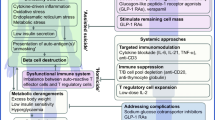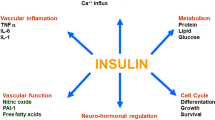Abstract
This study was performed to understand whether P165 improves learning and memory by restoring insulin action using a diabetes mellitus (DM) rat model. A total of 34 male Sprague–Dawley rats were randomly divided into four groups: control group (n = 8), DM group (n = 8), DM group treated with a low dose of P165 (n = 9), and DM group treated with a high dose of P165 (n = 9). After 8 weeks of treatment, the animals were killed and the expression of insulin signaling-related proteins was examined in the hippocampus by Western blot and immunohistochemical staining. Administration of P165 in diabetic rats did not induce a significant effect on the fasting blood glucose level. The expression of IR, IRS-1, AKT, p-CREB, and Bcl-2 proteins was significantly enhanced in the hippocampus in diabetic rats. Treatment of diabetic rats with P165 at both low and high doses significantly attenuated the expression levels of these proteins. Moreover, immunohistochemistry staining showed that IR, IRS-1, AKT, p-CREB, and Bcl-2 were abundantly expressed in the CA1 region of the hippocampus. The number of cells positively stained for the above proteins was significantly higher in diabetic tissues compared to control tissues, whereas P165 treatments induced a significant reduction in the expression of these proteins. The expression of IR, IRS-1, AKT, p-CREB, and Bcl-2 was enhanced in DM rats, and administration of P165 normalized the expression of these molecules, suggesting that P165 can improve impaired insulin signal transduction.




Similar content being viewed by others
References
Wei B, Frank BH, Shuang R et al (2013) Predicting risk of type 2 diabetes mellitus with genetic risk models on the basis of established genome-wide association markers: a systematic review. Am J Epidemiol 178:1197–1207
Namba M, Katsuno T, Kusunoki Y et al (2013) New strategy for the treatment of type 2 diabetes mellitus with incretin-based therapy. Clin Exp Nephrol 17:10–15
Callisaya M, Moran C (2013) Type 2 Diabetes mellitus as a causal factor for dementia-is there sufficient evidence from interventional studies? Australas epidemiol 20:26–28
Sung MS, Hyundong S, Jayoung B et al (2012) Altered APP processing in insulin-resistant conditions is mediated by autophagosome accumulation via the inhibition of mammalian target of rapamycin pathway. Diabetes 61:3126–3138
Profenno LA, Porsteinsson AP, Faraone SV (2010) Meta-analysis of Alzheimer’s disease risk with obesity, diabetes, and related disorders. Biol Psychiatry 67:505–512
Triggle CR, Howarth A, Cheng ZJ et al (2005) Twenty-five years since the discovery of endothelium-derived relaxing factor (EDRF): does a dysfunctional endothelium contribute to the development of type 2 diabetes? Can J Physiol Pharmacol 83:681–700
Vogt MC, Brüning JC (2013) CNS insulin signaling in the control of energy homeostasis and glucose metabolism-from embryo to old age. Trends Endocrinol Metab 24:76–84
Liu L, Yan T, Jiang L et al (2013) Pioglitazone ameliorates memory deficits in streptozotocin-induced diabetic mice by reducing brain β-amyloid through PPARγ activation. Acta Pharmacol 34:455–463
Zhao YM, Pei JJ, Ji ZJ et al (2003) Effect of amyloid precursor protein 17-mer peptide on microtubule structure and tau protein hyperphosphorylation in hippocampal neurons of experimental diabetic mice. Neuro Report 14:61–66
Meng Y, Wang R, Yang F et al (2010) Amyloid precursor protein 17-mer peptide ameliorates hippocampal neurodegeneration in ovariectomized rats. Neurosci Lett 468:173–177
Yao J, Wang R, Ji Z et al (2007) The in vitro experimental research on neurotrophic effect of the analogs of APP 5-mer peptide. Chin J Mult Organ Dis Elder 6:52–56
Duron E, Olivier H (2008) Vascular risk factors, cognitive decline, and dementia. Vasc Health Risk Manag 4:363–381
Han X, Ma Y, Liu X et al (2012) Changes in insulin-signaling transduction pathway underlie learning/memory deficits in an Alzheimer’s disease rat model. J Neural Transm 119:1407–1416
Biessels GJ, van der Heide LP, Kamal A et al (2002) Ageing and diabetes: implications for brain function. Eur J Pharmacol 441:1–14
Son SM, Jung ES, Shin HJ et al (2012) Aβ-induced formation of autophagosomes is mediated by RAGE-CaMKKβ-AMPK signaling. Neurobiol Aging 33:11–23
Shen C, Chen Y, Liu H et al (2008) Hydrogen peroxide promotes Abeta production through JNK-dependent activation of gamma-secretase. J Biol Chem 283:17721–17730
Yamamoto KT, Miyoshi T, Yea K et al (1994) The survival of rat cerebral cortical neurons in the presence of trophic APP peptide. J Neurobiol 25:585–594
Roch JM, Masliah E, Roch-Levecq AC et al (1994) Increase of synaptic density and memory retention by a peptide representing the trophic domain of the amyloid beta/A4 protein precursor. Proc Natl Acad Sci USA 91:7450–7454
Zhang J, Meng Y, Wang R et al (2008) Effect of Wortmannin and APP 17-mer peptide on insulin signal transduction pathway of SY5Y cells. Chin J Diabetes 16:429–431
Acknowledgments
This work was supported by the following grants: Beijing Natural Science Foundation (7132044), Capital Health Development Research Fund (2011-1001-02).
Author information
Authors and Affiliations
Corresponding author
Rights and permissions
About this article
Cite this article
Ma, L., Shao, Z., Wang, R. et al. The β-amyloid precursor protein analog P165 improves impaired insulin signal transduction in type 2 diabetic rats. Neurol Sci 36, 593–598 (2015). https://doi.org/10.1007/s10072-014-1997-9
Received:
Accepted:
Published:
Issue Date:
DOI: https://doi.org/10.1007/s10072-014-1997-9




